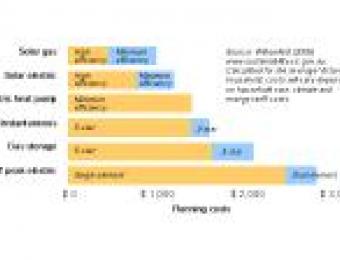NPE-A2 Series - Navien - recirculation pump
Traditionally, when you turn on the hot tap after not having used it for a while, a lot of cold water which has been sitting in the pipes comes out first. In most cases this ‘run off’ water is left to go down the drain while you wait for the water to get warm. A hot water recirculation system is intended to reroute that cold water back to the storage tank for heating, and provide instant hot water to every hot water outlet in the house.
There are two main types of recirculation system. One is generally found in new homes that have had the plumbing designed with recirculation in mind. It involves the installation of a pipe at the end of your house’s hot water network which connects to the hot water tank. This is called the return line. As the water passes through the pipes it comes across a thermostatically controlled valve that tests the water temperature. A circulator pump pushes any water that doesn’t reach the desired warmth back along the return line to your water heater. When the water reaches the right heat, the valve shuts off and the hot water is allowed to flow. For homes with existing plumbing, there is a retrofit available. Instead of installing a dedicated return line, it connects to and uses the cold water piping instead. The disadvantage to the retrofit is that by using the cold water supply it will let through any water that might still be warm, but not quite warm enough. If the cold tap is turned on, the water will be warmed by the returned hot water.
A hot water recirculation system, also known as a 'demand system', is system that connects to your plumbing to ensure that a constant flow of hot water is immediately available when the tap is turned on. It achieves this by pumping hot water through the pipes from your hot water system, either at preset times during the day or when the water at the tap drops below a certain temperature. A hot water recirculation system typically consists of either a single recirculation pump (often called a comfort pump), or a pump and a valve (for retrofitted systems).
In contrast to most conventional direct-fired tanks, indirect-fired Vitocell tanks from Viessmann use the heating water from a boiler to heat the tank water. Space heating and domestic hot water production are integrated into one system for maximum performance and efficiency.

Stainless steel domestic hot water tanks for a lifetime of hygienic domestic hot water heating. The 119 USG model is silver, all other models are white. Capacity: 42 to 119 USG - 160 to 450 L
Founded in 1917 as a heating technology manufacturer, and now part of Carrier, today we are one of the world’s leading providers of efficient climate (heating, water and air quality) and renewable energy solutions. Creating living spaces for generations to come – this is the responsibility that we take on every day together with our (trade) partners.
For the Vitocell 300 series, both the tank and heat exchanger of are made of high-grade stainless steel, a material known for its durability, hygiene, corrosion-resistance and long service life. And with a limited lifetime warranty in residential applications, you can be sure your investment will deliver long-lasting value, year after year. For detailed terms and conditions, see the warranty sheet.

189 GPH (715 L/h) for EVIB-42 190 GPH (719 L/h) for EVIB-53 269 GPH (1018 L/h) for EVIB-79 301 GPH (1139 L/h) for EVIB-119
A particularly important consideration when installing a recirculation system is the efficiency of the insulation fitted to your home's plumbing. Insufficient lagging on pipes can dramatically increase the running costs of a recirculation system.
47 inches (1190 mm) for EVIB-42 55½ inches (1410 mm) for EVIB-53 68½ inches (1740 mm) for EVIB-79 77 inches (1960 mm) for EVIB-119

A recirculation system will save the water that would normally be wasted while waiting for the hot water to warm up. It will also save time by fast tracking the hot water to your outlet, so it’s there and ready whenever you turn on the tap. The circulation pump does require electricity (which needs to be accounted for in any assessment of cost), but the amount of water a recirculation system can save is quite substantial. Likewise, the electricity used can be reduced by choosing a circulation pump that operates from a timer, so that it’s only circulating hot water when you’re likely to need it most - for example, just in time for your morning shower!
Vitocell 300-V domestic hot water tanks are made of high-alloy stainless steel to satisfy the highest expectations with respect to hygiene, recovery rates and service life expectancy. The large heat exchanger surfaces of the tank coil ensure an abundant supply of hot water and even water temperatures all day long.
Installing a new boiler is a major decision and there are many options available. So how do you know which boiler is the best one for your home?
"The whole is greater than the sum of its parts." According to this philosophy, Viessmann does not just make individual heating equipment components that meet the high Viessmann standards for quality, reliability and effectiveness. Rather, all products are part of a matching concept, where all components complement one another. Viessmann system technology includes everything you need for a reliable and economical heating system. The Vitotronic control unit with remote control, the powerful Vitocell DHW tanks for best DHW convenience, to high-quality solar thermal systems for cost-saving heating.
With a range of hot water heating options available, what's your best bet? Learn more about combi boilers and DHW tanks, to help find out what would work best for your family.




 8615510865705
8615510865705 
 8615510865705
8615510865705